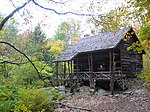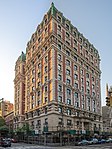American Museum of Natural History

The American Museum of Natural History (abbreviated as AMNH) is a private 501(c)(3) natural history museum on the Upper West Side of Manhattan in New York City. In Theodore Roosevelt Park, across the street from Central Park, the museum complex comprises 26 interconnected buildings housing 45 permanent exhibition halls, in addition to a planetarium and a library. The museum collections contain over 34 million specimens of plants, animals, fossils, minerals, rocks, meteorites, human remains, and human cultural artifacts, as well as specialized collections for frozen tissue and genomic and astrophysical data, of which only a small fraction can be displayed at any given time. The museum occupies more than 2 million square feet (190,000 m2). AMNH has a full-time scientific staff of 225, sponsors over 120 special field expeditions each year, and averages about five million visits annually.The mission statement of the American Museum of Natural History is: "To discover, interpret, and disseminate—through scientific research and education—knowledge about human cultures, the natural world, and the universe."
Excerpt from the Wikipedia article American Museum of Natural History (License: CC BY-SA 3.0, Authors, Images).American Museum of Natural History
Central Park West, New York Manhattan
Geographical coordinates (GPS) Address Phone number Website External links Nearby Places Show on map
Geographical coordinates (GPS)
| Latitude | Longitude |
|---|---|
| N 40.780555555556 ° | E -73.974722222222 ° |
Address
American Museum of Natural History
Central Park West 180
10024 New York, Manhattan
New York, United States
Open on Google Maps




